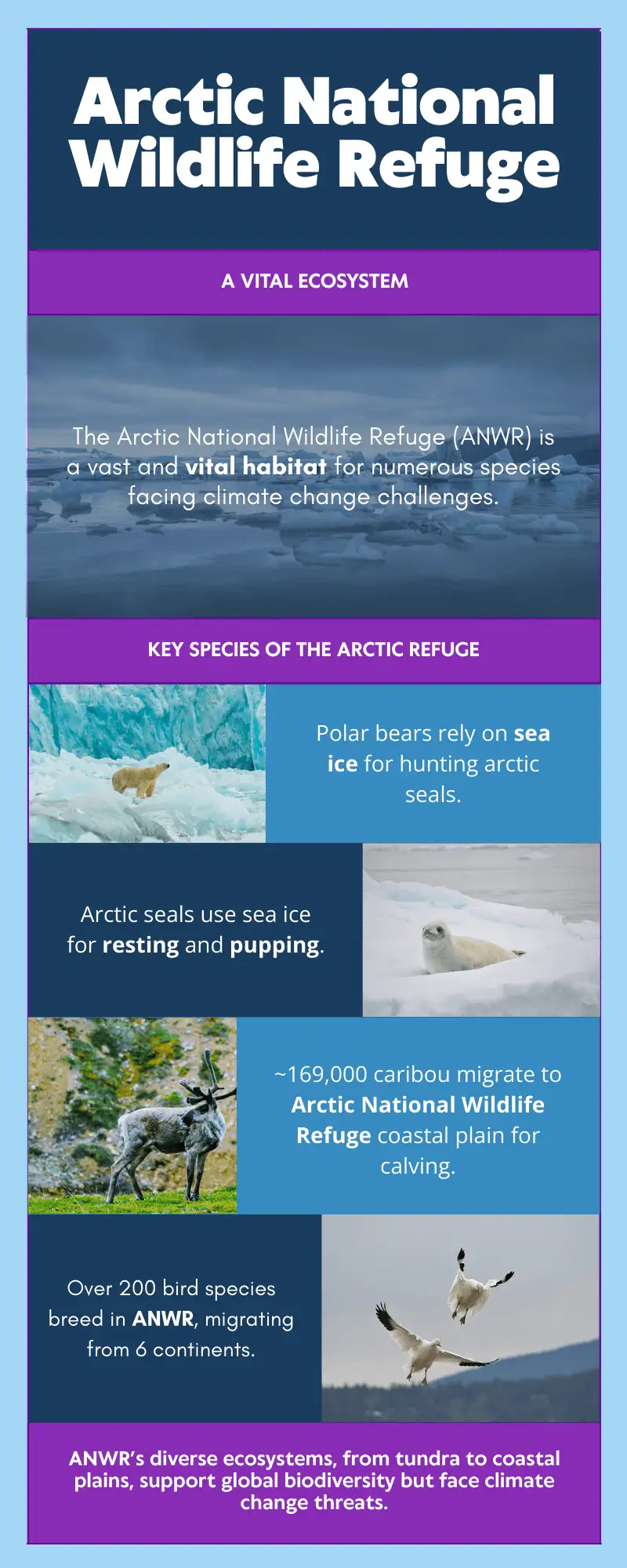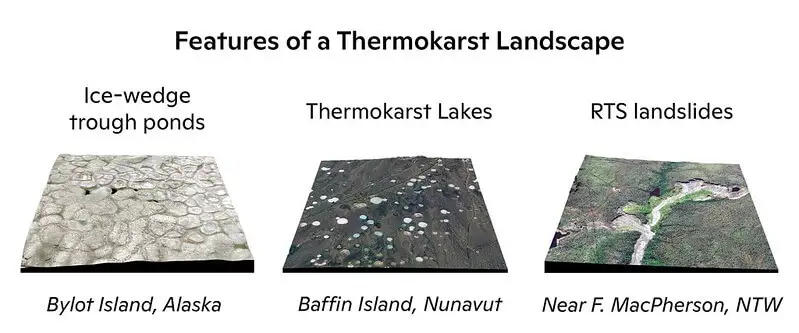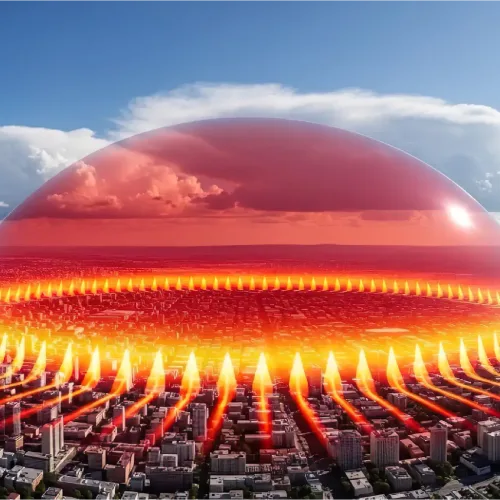The Arctic region is undergoing extraordinary changes, with its temperature rising significantly. The rise of temperature is two to four times faster than any other part of the Earth. These stats are shocking. This significant change is centered on the Arctic wildlife refuge. It is a diverse region in Alaska that is home to many kinds of unique wildlife species. Rapidly melting glaciers and dramatic images of wandering polar bears often make headlines. However, the profound and damaging effects of climate change on this crucial ecosystem and its inhabitants largely to stay unknown.
What hidden changes within this vital refuge put threats to Arctic wildlife? How these environmental changes posing threats to species like polar bears, Arctic seals, and the famous caribou? The purpose of this article is to seek answers to these questions. We will explore the effects that are changing the lives of animals in the Arctic national wildlife refuge that are mostly overlooked. We will also uncover the hidden ways in which climate change in challenging this ecosystem. The image below demonstrates that the ANWR region is at a critical stage.

The Arctic National Wildlife Refuge
The Arctic national wildlife refuge is a region in northeastern Alaska spanning over 19 million acres. This large region, is commonly known as Arctic refuge, is a symphony of breathtaking landscapes. It includes everything from coastal plains to the Arctic Ocean to rugged mountain ranges, tundra, and boreal forests.
This huge wilderness is about the same size as South Carolina. It’s incredible that so many arctic animals call this place their home. These include polar bears, arctic foxes, and wolves. There are over 200 species of birds that fly in from all 50 states and even six different continents. The coastal plain, known as the “1002 area,” and it’s super important for the Porcupine Caribou Herd, which has around 169,000 individuals. That’s a lot of caribou! Plus, this area is like a breeding hotspot for seabirds. When you look at the waters, you’ll find marine life thriving, too, like arctic seals and beluga whales. This biodiversity is shown in the infographic below. It really highlights how vital this refuge is to Arctic ecology. Rapid changes in the environment are now putting all of this at risk.

Climate Change in the Arctic Region
Climate change is already affecting the Arctic region, changing its environment in big and small ways. The ice is melting, and the ground and seasons are changing. All of this has a pretty significant impact on the animals that call this place home.
It’s like a domino effect that everything is interconnected. We’ve got permafrost thawing. Snow cover is changing. New plants are popping up and can throw off the natural order of things. It’s not just a coincidence, these shifts are creating a ripple effect throughout the ecosystem. Honestly, holding these changes is crucial if we want to understand how they’re affecting the animals in this unique and fragile environment.
Melting Permafrost and Its Ripple Effects
Permafrost is the permanently frozen ground that covers about 85% of the Arctic National Wildlife Refuge. It’s very important for keeping the Arctic environment in balance. I mean, it stabilizes the land, manages the water flow, and it’s like a huge storage unit for old carbon, more than the double of what we have floating around in the atmosphere right now.
But, when our planet warms up, this frozen ground is starting to melt at an alarming rate. So, what happens when permafrost thaws? Well, a lot of changes. The ground can suddenly become uneven, creating these weird formations known as thermokarsts. It’s a kind of fascinating, but it can really throw a wrench in how water moves around. Some areas might suddenly have new lakes and wetlands popping up, while other spots may dry out completely. And then there’s the issue of gases like methane and carbon dioxide getting released into the atmosphere. Those are not good for us. They just make global warming even worse.

Shifting Seasons: Snow and Plant Life
The changes we’re seeing in the Arctic seasons are really causing troubles up for both plants and animals in Alaska’s wildlife refuge. In the past, snow melting and freezing happened at predictable times, which helped life in the area. But nowadays, spring is showing up earlier than expected, which means the snow is melting sooner, and the ground is getting uncovered earlier too.
These changes really conflict with the timing of when plants grow, bloom, and eventually produce fruit. If the plants and animals can’t synchronize, the animals that rely on these plants might struggle. They may not find the right food. These animals include caribou and muskoxen. They may not find it when they need it. And that’s a big deal! It could mean less nutrition for them, slower growth rates, and fewer little ones to carry on their species. And guess what? This whole situation doesn’t just affect them; it ripples up the food chain to the predators that rely on these herbivores in the Arctic refuge. It’s a tricky balance, but things are getting complicated out there!
The Food Web Under Strain: Cascading Ecological Impacts
The environmental changes happening in the Arctic National Wildlife Refuge (ANWR) are really making an impact throughout the entire food web. Both marine animals and land species are dealing with a bunch of challenges that are all connected. I’m talking about things like losing their habitats and struggling to find enough food. And honestly, it’s starting to throw the whole ecosystem out of whack.
Unseen Challenges for Marine Mammals and Birds
Arctic seals rely on sea ice for a bunch of crucial activities like resting, giving birth, and hunting for food. It’s interesting, even a bit of ice loss can force them to travel many farther distances. And you know what that means? More energy spent, which ultimately makes it tougher for them to raise their young ones. If we look at polar bears over in Svalbard, it’s kind of the same story. They’re facing similar challenges, like losing their habitats and finding it harder to get a meal.
Check out the table below, it really puts the light on how these changes ripple through marine life. It’s a pretty clear picture of the larger issues facing both polar bears and the whole Arctic ecosystem.
| Species/Group | Climate Change Impact | Effect on Behavior/Habitat | Broader Context |
|---|---|---|---|
| Arctic Seals | Reduced Sea Ice Extent | Longer travel distances reduces their energy and the chances of having babies and for resting. | Seals in other Arctic areas have similar problems because melting ice makes it hard for them to breed. |
| Arctic Seals | Ocean Acidification | Changes in ocean chemistry hurt fish and shellfish, which results in insufficient food. | These issues are akin to what’s happening around the world in ocean ecosystems, putting seal numbers at risk. |
| Seabirds | Altered Plankton Blooms | Broken food chains make it harder to find food, which affects how well chicks survive. | Seabird numbers are also going down in other Arctic places because there isn’t enough food. |
| Seabirds | Shifting Migratory Patterns | Warmer weather and changing ice patterns mess up breeding and migration schedules. | We see similar changes in Arctic bird populations, which impacts bird migration around the world. |
| Polar Bears | Reduced Sea Ice | Fewer hunting areas for seals create food stress, affecting their ability to reproduce. | Svalbard polar bears face the same issues, as losing ice makes them depend more on food found on land. |
The Porcupine Caribou Herd’s Journey
The Porcupine caribou herd undertakes an astonishing migration of 1500 miles from Canada to the Arctic National Wildlife Refuge. However, climate change poses significant hurdles to their journey. When permafrost melts, the migration routes of the caribou are changed. The intense heat increases the torment caused by insects, forcing the caribou to use more energy. As a result, the health and survival of their herds are put at high risk.
Indigenous Perspectives and Conservation Efforts
The Gwich’in and Iñupiat, you know, they have such a rich connection to the wildlife in the Arctic National Wildlife Refuge. It’s more than just land to them, it’s part of their culture and identity. Their knowledge about the environment is pretty incredible, and it plays a crucial role in conservation efforts. They combine their traditional knowledge with modern scientific approaches, which is really important to protect the delicate ecosystem up there in the Arctic.
Collaborative Conservation Initiatives
The organizations, like the Wildlife Conservation Society and the National Audubon Society, are teaming up with Indigenous communities to help protect the Arctic National Wildlife Refuge. The Gwich’in Steering Committee is working hard on monitoring caribou populations, which is so important. They’re all about saving bird habitats, which makes a huge difference for the local wildlife. This approach not only respects the heritage of these communities but also promotes the sustainable conservation practices. It’s like a win-win for everyone involved!
Conclusion
Climate change is hitting the Arctic wildlife refuge hard. We’re talking about things like thawing permafrost and messed-up food webs that are putting its incredible biodiversity at serious risk. I mean, this place is home to polar bears, caribou, and a bunch of other species, it’s just so vital.
Honestly, the challenges it’s facing right now are unlike anything we’ve seen before. We really need to step up our efforts. Supporting conservation efforts is essential. Cutting down our carbon footprints is important. We must push for smart climate policies. These all steps are very important if we want to protect this precious ecosystem.
If we can raise awareness and convince people to take action, we have a real chance at keeping the Arctic wildlife refuge as a safe haven for wildlife animals.




